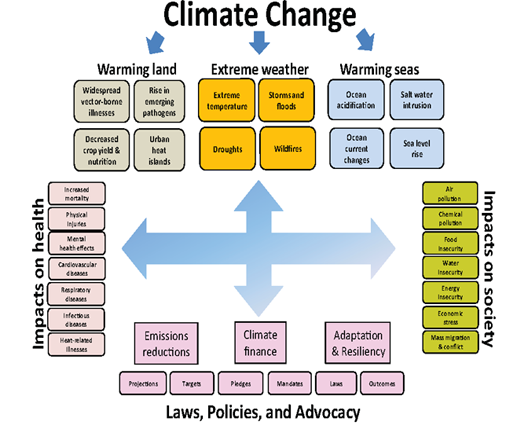Climate Change Impacts & Responses
Figure shows the effects of climate change on the world at the top and its impacts on human health and society on the sides, with possible ways to respond to the crisis at the bottom (by S. DasSarma).
United States Climate Targets and Actions
In the spring of 2021, the United States set in its Nationally Determined Contribution (NDC) to greenhouse gas emissions an economy-wide target of reduction of 50-52 percent below 2005 levels by 2030 (see US State Department Climate Crisis website). In November of 2021, the United States Long-Term Strategy targeted a goal of 100% clean electricity by 2035, which would reduce air pollution, avoiding 85,000–300,000 premature deaths and health and climate damages of $150–$250 billion through 2030. In August of 2022, the United States passed and President Biden signed into law the Inflation Reduction Act (IRA), the most ambitious climate action in history, providing $369 billion in funding for climate and sustainability measures over ten years. The law seeks to make health care more equitable, promote climate resiliency, and reduce air pollution through investments in renewable energy.
Maryland Climate Targets and Actions
In the spring of 2022, Maryland’s Climate Solutions Now Act (CSNA) was passed by the legislature and became law, requiring the state to reduce greenhouse gas emissions by 60 percent below 2006 levels by 2031 and achieve Net Zero by 2045. In December of 2023, Maryland's Department of the Environment released the Climate Pollution Reduction Plan which provides a pathway to achieve the goals of the CSNA (see MDE's Climate Change Program). In June 2024, Maryland’s Governor Moore signed an executive order implementing Maryland's CPRP (see press release). These climate laws and policies are expected to generate upwards of $1.2 billion in public health benefits and a net gain of 27,400 jobs by 2031.

